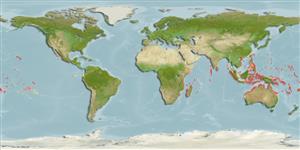>
Gobiiformes (Gobies) >
Gobiidae (Gobies) > Gobiinae
Etymology: Eviota: No etymology given, suggested by Christopher Scharpt: from Latin 'eu' for 'true' and 'iota' for anything very small, in combination 'truly very small' referring to it as being the smallest vertebrate at the time it has benn described by Jenkins (thus, making the suggestion by Scharpt plausible.
More on authors: Jewett & Lachner.
Environment: milieu / climate zone / depth range / distribution range
Ekologi
laut berasosiasi dengan karang; kisaran kedalaman 0 - 3 m (Ref. 89972). Tropical; 26°N - 32°S
Pacific Ocean: known only from the Society islands, Line Islands and Tuamotu Archipelago. Occurrence in other countries refer to Eviota guttata (restricted to the Red Sea) and E. teresae (Fiji, and as E. cf. terasae in other Western Pacific countries).
Size / Weight / umur
Maturity: Lm ? range ? - ? cm
Max length : 3.6 cm TL jantan/; (Ref. 89972)
deskripsi pendek
Kunci identifiaksi (pengenalan) | Morfologi | Morfometrik
This species is distinguished by having a scattering of melanophores obliquely across the pectoral-fin base that is concentrated in the center; two distinct bands of melanophores extending posteriorly from the eye, the upper one is narrow, from eye to above the pectoral-fin base and the lower is broader and extends across the cheek onto the opercle, both of which are the two red bands extending back from the eye when fresh (Ref. 83982); no dark spots on ventral side of head on isthmus (Ref. 113727). Dorsal to anal fin-ray formula 9/8 (Ref. 116739).
Occurs in shallow lagoon and channel reefs at depths usually less than 3 m.
Life cycle and mating behavior
Kematangan | Reproduksi, perkembang biakan | Pemijahan | telur-telur | Fecundity | Larva
Greenfield, D.W. and J.E. Randall, 2010. Four new gobiid fishes of the genus Eviota from the Western Pacific, with clarification of Evoita guttata and Evoita albolineata (Teleostei: Goblidae). Proc. Calif Acad. Sci. 61(3):269-289. (Ref. 83982)
Status IUCN Red List (Ref. 130435: Version 2024-1)
ancaman kepada manusia
Harmless
penggunaan manusia
Alat, peralatan
laporan khas
muat turun XML
Sumber internet
Estimates based on models
Preferred temperature (Ref.
123201): 25.1 - 29.3, mean 28.4 °C (based on 2117 cells).
Phylogenetic diversity index (Ref.
82804): PD
50 = 0.5000 [Uniqueness, from 0.5 = low to 2.0 = high].
Bayesian length-weight: a=0.00692 (0.00284 - 0.01683), b=3.10 (2.92 - 3.28), in cm total length, based on LWR estimates for this Genus-body shape (Ref.
93245).
Trophic level (Ref.
69278): 3.1 ±0.3 se; based on size and trophs of closest relatives
Daya lenting (Ref.
120179): Tinggi, Waktu penggandaan populasi minimum kurang dari 15 bulan (Preliminary K or Fecundity.).
Fishing Vulnerability (Ref.
59153): Low vulnerability (10 of 100).
Nutrients (Ref.
124155): Calcium = 370 [165, 975] mg/100g; Iron = 1.37 [0.62, 2.98] mg/100g; Protein = 17.9 [15.8, 19.7] %; Omega3 = 0.0832 [, ] g/100g; Selenium = 19.9 [6.5, 58.0] μg/100g; VitaminA = 120 [25, 524] μg/100g; Zinc = 3.72 [2.11, 6.24] mg/100g (wet weight);
